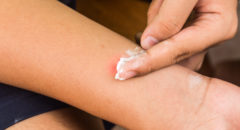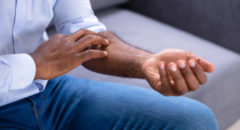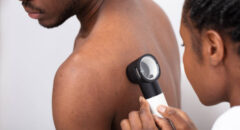
A sudden skin rash can be a puzzling and alarming symptom in a child. But as one expert explains, rashes are common in kids and often caused by eczema or an allergic reaction.
Eczema
"Eczema is a disease that causes patches of dry skin, which is often accompanied by intense itching. Scratching can damage the skin, make the rash worse, and increase the risk for an infection," says Dr. JiaDe (Jeff) Yu, an assistant professor of adult and pediatric dermatology at Massachusetts General Hospital in Boston.
The most common form of eczema in children is atopic dermatitis, which usually starts very early in life.
Eczema goes away with time in many kids, but about half will still have it when they're adults. There's no way to know whether childhood eczema will continue into adulthood, but early diagnosis and treatment can prevent it from getting worse, according to Yu.
"About 20% of kids are affected by eczema, and sometimes allergic contact dermatitis can mimic eczema or develop on top of eczema, which makes it even harder to diagnose and treat," he said in an American Academy of Dermatology news release.
Symptoms of eczema include:
- Dry skin
- Itching, which may be severe, especially at night
- Red to brownish-gray patches, especially on the hands, feet, ankles, wrists, neck, upper chest, eyelids, inside the bend of the elbows and knees, and in infants, the face and scalp
- Small, raised bumps, which may leak fluid and crust over when scratched
- Thickened, cracked, scaly skin
- Raw, sensitive, swollen skin from scratching
RELATED: 10 Most Common Skin Rashes On Black Skin
Allergic contact dermatitis
Allergic contact dermatitis is a skin reaction to allergens. The most common allergens are metals such as nickel and cobalt, which can be found in costume jewelry, clothing parts such as belt buckles and jean snaps, toys, furniture and school chairs.
Fragrances and preservatives are other common allergens. They can be found in personal care products such as body washes and shampoos, as well as in laundry detergents.
Some chemicals and dyes in clothing can also cause allergic contact dermatitis. So can adhesives, including those used in wearable blood glucose monitors, and a chemical used in sports shin guards.
Symptoms of contact dermatitis include:
- A red rash
- Itching, which may be severe
- Dry, cracked, scaly skin
- Bumps and blisters, sometimes with oozing and crusting
- Swelling, burning or tenderness
RELATED: How To Tell If Your Skin Rash Needs A Doctor
Getting the proper treatment
It's important, Yu says, to get the correct diagnosis so your child can receive proper treatment.
"While eczema can be effectively managed, the best way to treat allergic contact dermatitis is to avoid the allergen once it has been identified," he shares.
For example, if fragrances cause an allergic reaction, use products without them. But don't be fooled: Products marked "unscented' have a fragrance that is masked but can still irritate the skin. Yu suggests avoiding them and looking for fragrance-free products.
Also, be cautious about products labeled as "clean" or "natural." The U.S. Food and Drug Administration has no specific guidelines for labeling a product as such.
"These are just buzzwords that companies put on products to tell consumers that some of the ingredients are potentially derived from natural sources," Yu adds. "As I tell my patients, although poison ivy is natural, you wouldn't want to use a product containing it."
If you notice rashes or any other abnormalities on your child's skin, it's important to consult with your child's doctor. He or she can perform patch testing or other tests to rule out other skin conditions. If you suspect a certain food, product, etc. is the root of your child's skin rash, notify the doctor so that he or she can identify any potential allergies your child may have.
Essentially, the Mayo Clinic suggests seeking medical attention if:
- The rash is so uncomfortable that your child is losing sleep or distracted from daily activities
- The rash is sudden, painful, severe or widespread
- The rash doesn't get better within three weeks
- The rash affects your child's face or genitals
Seek immediate medical care in the following situations:
- You think your child's skin is infected. Clues include fever and pus oozing from blisters.
- Your child's lungs, eyes or nasal passages are painful and inflamed, perhaps from inhaling an allergen.
- You think the rash has damaged the mucous lining of your child's mouth and digestive tract.









